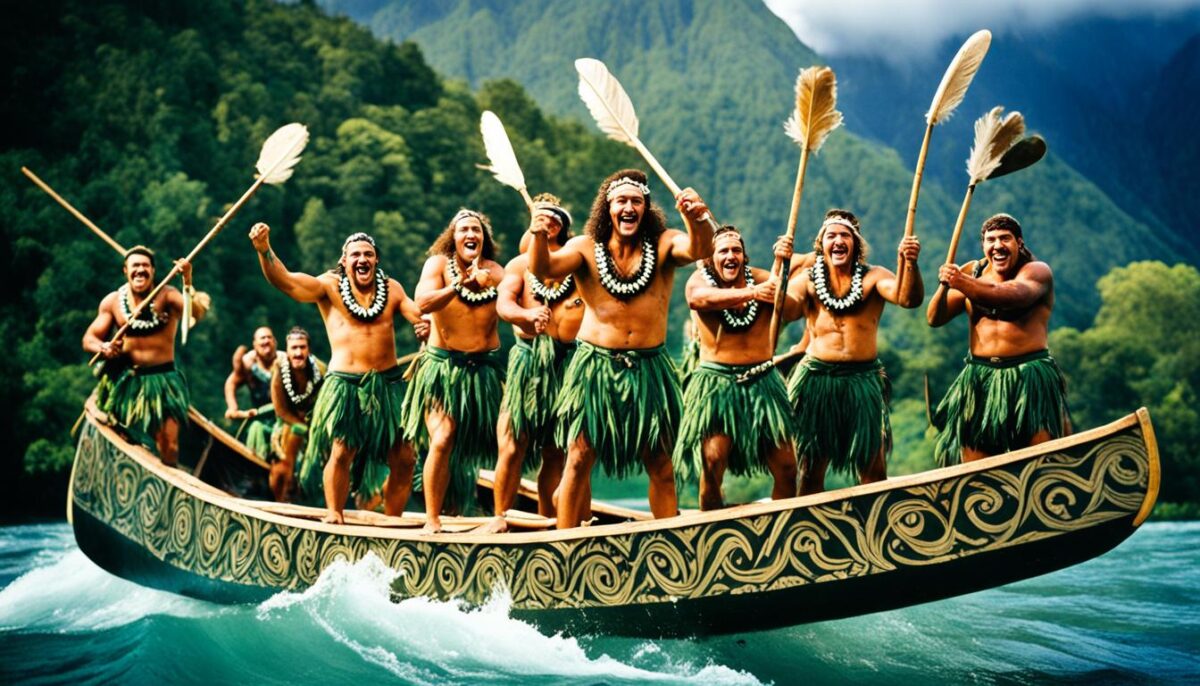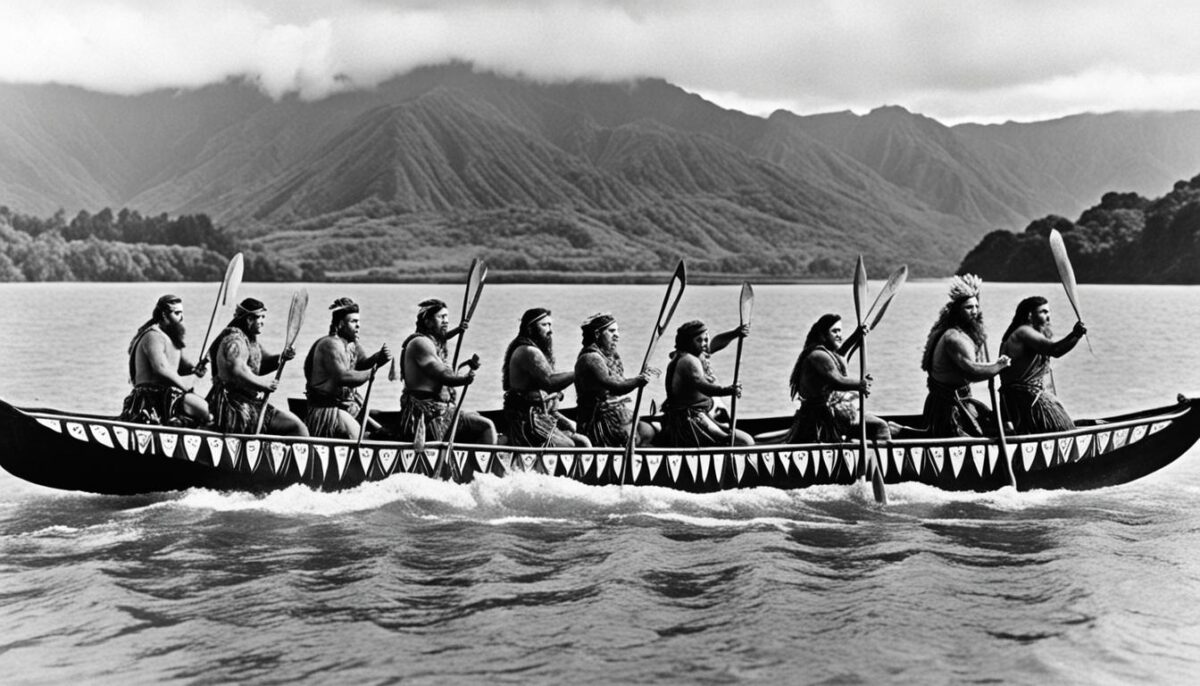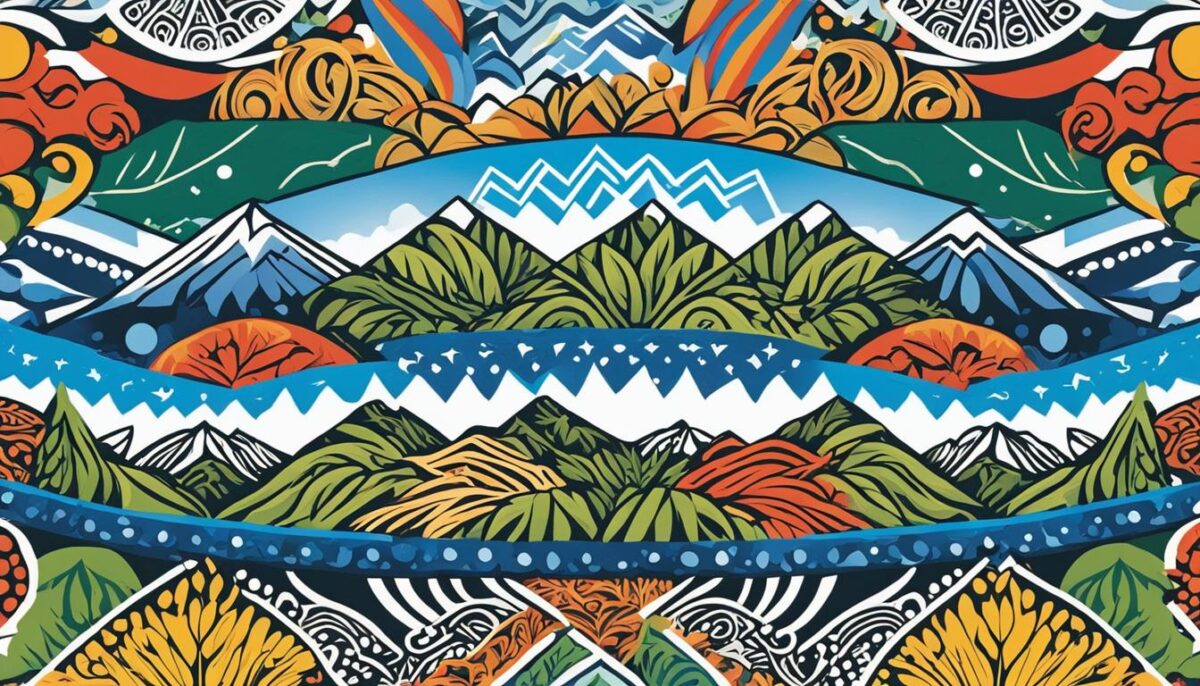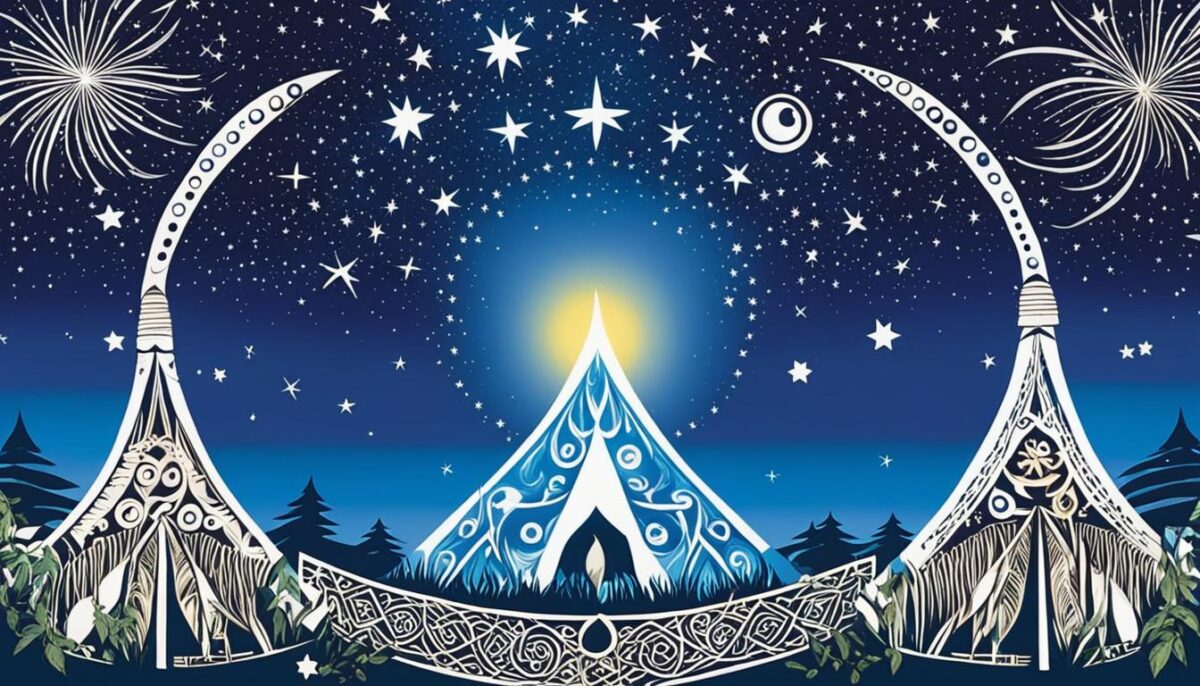In this article, we will embark on a captivating journey through time to explore the arrival of the Maori people in the breathtaking landscapes of New Zealand. Uncovering the rich history and cultural heritage of the Maori settlement, we’ll delve into the significant events that shaped their presence in this magnificent country.

A group of Maori people standing on the deck of a large canoe, with lush mountains and trees visible in the background. The people look excited and determined, with their faces painted and adorned with feathers. Some of them hold paddles, while others have fishing nets and harpoons. The water beneath the canoe is calm, but there are hints of rougher waves in the distance.
The story of the Maori people’s arrival in New Zealand is a tale steeped in ancient traditions and legends. Through their migration, they established a vibrant society, nurturing a connection with the land and leaving an indelible mark on the cultural fabric of New Zealand.
Join us as we traverse the past to uncover the origins of the Maori people, journeying from their ancestral ties to the Polynesian cultures to their navigation prowess in making the voyage to New Zealand. We will explore traditional dating methods, archaeological findings, and modern scientific techniques that have helped piece together this extraordinary chapter in Maori settlement history.
Prepare to be enthralled by the stories, heritage, and legacies of the Maori people as we dive deep into the fascinating timeline of their arrival in New Zealand.
The Origins of the Maori People
When exploring the rich history of the Maori people, it is essential to understand their origins and ancestral connections to ancient Polynesian cultures. The Maori are descendants of Polynesian voyagers who undertook a remarkable journey of migration from the mythical homeland of Hawaiki to New Zealand.
Their migration from Hawaiki to New Zealand, known as the Polynesian migration, is a significant event that shaped the cultural landscape of both regions. While the exact timeline and routes of their migration are still debated among scholars, various theories and evidence shed light on this incredible journey.
“The Maori people carry a deep reverence for their ancestors, who navigated vast oceanic distances using celestial navigation techniques and their intimate knowledge of the stars and natural elements.”
According to oral traditions passed down through generations, Hawaiki is believed to be the ancestral homeland of the Maori people. Though Hawaiki’s geographical location is a subject of speculation, it remains a pivotal part of Maori mythology and cultural identity.
The Polynesian migration was a testament to the Maori people’s exceptional navigation abilities and seafaring skills. Brave explorers ventured into the vast Pacific Ocean, using their knowledge of stellar constellations, ocean currents, and the behavior of migratory birds to traverse the waters.
Arriving in New Zealand, the Maori brought with them their rich cultural heritage, customs, and traditions, which continue to thrive to this day. Their connection to the land, deep respect for nature, and strong community bonds shape the unique Maori identity.
As we delve deeper into the origins of the Maori people, we gain a greater understanding of their ancestral ties, the monumental Polynesian migration, and the enduring legacy of their vibrant culture.

Show a group of Maori ancestors arriving on a waka (canoe) to the shores of Aotearoa (New Zealand). The waka should be made of natural materials and have intricate carvings on the sides. The ancestors should have traditional tattoos (tā moko) on their faces and wear woven kākahu (clothing) made from flax. The scene should be set at dawn with mist rising from the water and the outlines of mountains in the background. The ancestors should look determined and strong, ready to start their new lives in this new land.
Key Takeaways
- The Maori people have ancestral connections to ancient Polynesian cultures.
- They migrated from the mythical homeland of Hawaiki to New Zealand.
- The exact timeline and routes of their migration are still debated.
- The Polynesian migration showcased the Maori people’s exceptional navigation abilities.
- The Maori brought their rich cultural heritage and traditions to New Zealand.
| Maori Ancestral Connections | Hawaiki | Polynesian Migration | Navigation Abilities | Maori Cultural Legacy |
|---|---|---|---|---|
| Ancestral ties to ancient Polynesian cultures. | Believed to be the ancestral homeland of the Maori people. | A remarkable migration from Hawaiki to New Zealand. | Exceptional navigation skills and seafaring abilities. | A vibrant culture with rich traditions. |
The Great Fleet and Traditional Dating
In Maori history, the concept of the Great Fleet, known as Te Heke Aranga, holds significant importance. This legendary fleet of canoes is said to have brought the Maori people to New Zealand. While the exact details of this migration are still debated among historians and scholars, traditional dating methods and oral traditions play a crucial role in establishing the timeframe of the Maori arrival.
The traditional dating methods utilized by Maori scholars are rooted in oral traditions passed down through generations. These oral traditions involve the sharing of stories, genealogies, and historical accounts, allowing the Maori people to preserve their cultural heritage and knowledge. Through careful interpretation and analysis of these oral traditions, Maori scholars have been able to reconstruct and chronicle the events surrounding the arrival of their ancestors.
The use of oral traditions as a historical source is unique to the Maori culture and provides valuable insights into their past. These traditions act as a living record, capturing not only historical facts but also the rich cultural and spiritual aspects of Maori society. By honoring and valuing these oral traditions, the Maori people have been able to maintain a strong connection to their roots and pass down their ancestral wisdom to future generations.
The Importance of Te Heke Aranga
Te Heke Aranga, also known as the Great Fleet, holds immense cultural significance for the Maori people. According to oral traditions, the arrival of the Great Fleet marked the beginning of Maori settlement in New Zealand. The fleet consisted of several canoes, each representing a distinct tribe or iwi. These canoes carried the ancestors of the Maori people and played a vital role in shaping their identity and heritage.
The stories and legends surrounding Te Heke Aranga serve as a foundation for Maori identity and historical understanding. They connect the Maori people to their ancestral roots and provide a sense of belonging and pride. The Great Fleet represents the collective migration and settlement of the Maori people, symbolizing their resilience, bravery, and inherent connection to the land.
As we delve deeper into Maori history, it becomes evident that oral traditions and traditional dating methods are essential in unraveling the mysteries of the past. They provide a unique perspective on Maori arrival, settlement, and cultural development, painting a vivid picture of the rich heritage and traditions that continue to thrive in New Zealand today.
Archaeological Evidence and Modern Dating Techniques
As we delve into the history of the Maori people in New Zealand, it is crucial to explore the significant role played by archaeological findings and modern dating techniques. These scientific advancements have provided invaluable insights into the timeline of Maori arrival and settlement on this beautiful land.
The extensive excavation of early settlements has unearthed a treasure trove of artifacts, offering glimpses into the Maori lifestyle and their interactions with the natural environment. From pottery fragments to tools and weapons, each discovery adds to our understanding of their rich cultural heritage and ancient traditions.
Radiocarbon dating, a widely used method in archaeology, has revolutionized our ability to accurately date organic materials found at these sites. This technique relies on the principle that carbon-14, a radioactive isotope, decays at a known rate. By analyzing the ratio of carbon-14 to carbon-12 in organic remains, scientists can estimate the age of the samples with remarkable precision.
Through the combination of archaeological findings and radiocarbon dating, researchers have been able to piece together the puzzle of Maori arrival and early settlement in New Zealand. These scientific methodologies have provided a more comprehensive and accurate timeline, further enhancing our understanding of the Maori people and their remarkable journey to this land.


